30 Effective Home Remedies To Reduce Stretch Marks
Learn the easiest natural ways to remove those stubborn streaks on your skin.
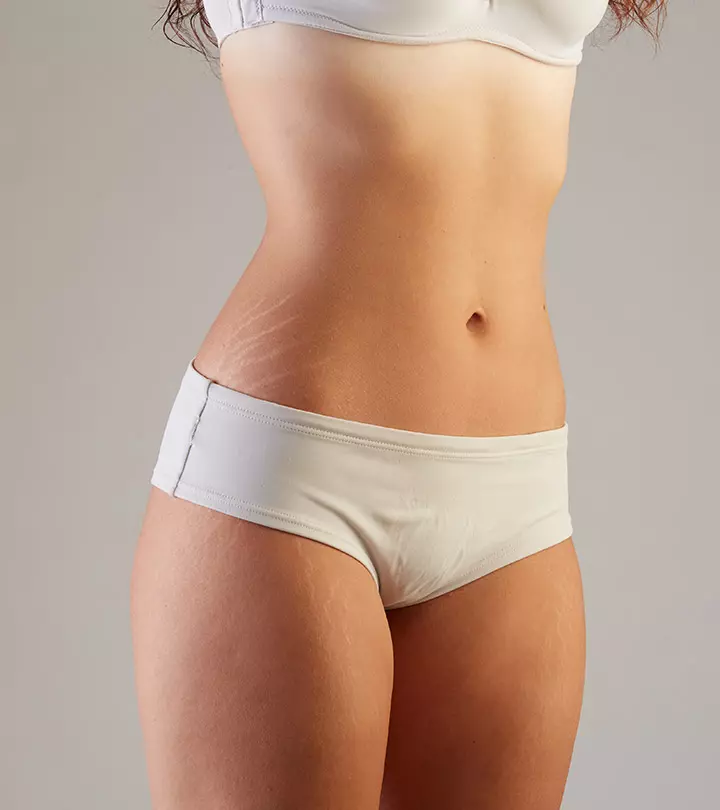
Image: Shutterstock
Stretch marks, also known as striae, are long thin lines that appear as a result of skin stretching. Weight gain, hormonal fluctuations, and pregnancy are some of the common causes of developing thin silver lines on your skin (1). These marks not only impact how your skin looks but also affects your self-esteem and body image. The good news is there are a few natural remedies that can help with stretch mark removal over time. In this article, we discuss some of the natural ingredients you can use to reduce the appearance of stretch marks over time. Scroll down to know more!

In This Article
Home Remedies For Stretch Marks
Moisturization is key to improving skin elasticity. Studies have found that keeping the skin moisturized using oils and emollients can help prevent stretch marks (2), (3). The remedies discussed below can help keep the skin moisturized, thus preventing and fading stretch marks.
Note: There is no scientific evidence to support the efficacy of any of the remedies for stretch marks. As these remedies are based on anecdotal evidence, not everyone may achieve the same results. Hence, it is best to consult a doctor before opting for any of these methods.
That said, you can learn how to get rid of red stretch marks naturally with the help of easily available home remedies listed below. Check them out.
1. Coconut Oil
Coconut oil
is traditionally used as a skin moisturizer (4). It may help to keep your skin moisturized and prevent stretch marks.
You Will Need
1 tablespoon virgin coconut oil
What You Have To Do
- Massage the coconut oil onto the affected area for 5-10 minutes.
- Make sure to massage it onto damp skin.
- You may leave the oil overnight or wash it off after 1-2 hours.
How Often You Need To Do This
2 times every day.
2. Cocoa Butter
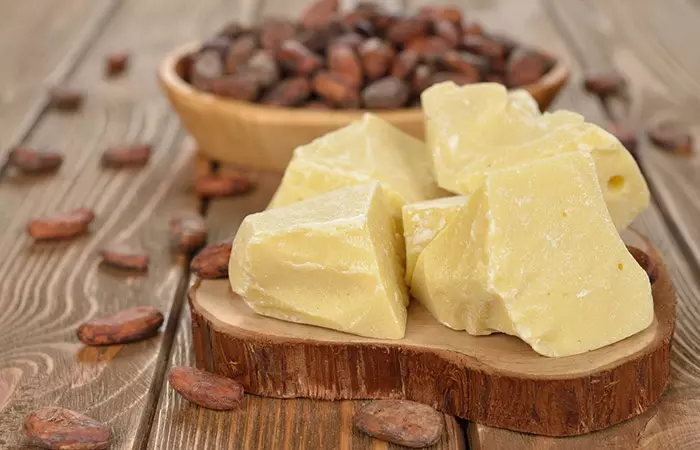
Cocoa butter has a moisturizing effect on the skin, although one study found that it had no significant impact on reducing stretch marks. Several formulas of ointments for stretch marks containing shea butter, cocoa butter, and vitamin E showed conflicting results. While they proved to be useful in some cases, they did not show any improvement in the others (2).
You Will Need
- ½ cup of cocoa butter
- ¼ cup shea butter
- 1 teaspoon of vitamin E oil
- 1 teaspoon of virgin coconut oil
What You Have To Do
- Mix the two butters and coconut oil.
- Heat them (if needed) for a few seconds to melt them.
- Add the vitamin E oil and mix well.
- Massage the mixture onto the affected area.
- Leave it on overnight or wash it after 1-2 hours.
How Often You Need To Do This
2 times every day.
3. Castor Oil
Castor oil contains ricinoleic acid and other ingredients that have a skin-conditioning (emollient) effect
(3). This may help improve the appearance of stretch marks.
You Will Need
1-2 tablespoons of castor oil (cold-pressed)
What You Have To Do
- Massage the castor oil onto the affected area.
- Leave it on overnight and wash off the next day.
How Often You Need To Do This
Every day before going to bed.
Fiona, a YouTuber, discusses her struggle with stretch marks, particularly on the arms, due to weight gain. She shares her journey of researching and trying various methods to address stretch marks, emphasizing the effectiveness of shea butter. In the video, she says, “It’s a process. For me, it’s taken months but it has helped me out so so much. I feel much confident and I can wear short sleeves stuff. So, that’s what’s helped me out a lot, and the reason being, I think, because shea butter is very thick oil and it doesn’t wear off quickly, so it just moisturizes your skin… deep moisturizing (i).”
 Quick Tip
Quick Tip4. Shea Butter

Shea butter is a natural emollient (2). Hence, it can keep your skin moisturized. This moisturizing effect may help improve the appearance of stretch marks over time. You can use shea butter in combination with cocoa butter or by itself.
You Will Need
½ cup of shea butter
What You Have To Do
- Melt the butter (by microwaving it for a few seconds).
- Massage it onto the affected area.
- Leave it on overnight and wash it off the next day.
How Often You Need To Do This
Every day before going to bed.
5. Aloe Vera
has moisturizing properties and promotes collagen development (4). This property of aloe vera may help to improve the appearance of stretch marks.
You Will Need
- 2 tablespoons of fresh aloe vera gel
- 1 teaspoon of vitamin E oil
What You Have To Do
- Mix both the ingredients.
- Massage the mixture onto the affected area.
- Leave it on for at least an hour.
- Wash it off.
How Often You Need To Do This
2 times every day.
6. Vick VapoRub
As per anecdotal evidence from beauty bloggers who have tried this remedy, Vicks VapoRub can help fade stretch marks. However, there is no scientific evidence to prove that Vicks VapoRub works for stretch marks. Avoid use if you have sensitive or broken skin.
You Will Need
- Vicks VapoRub
- Cling wrap
What You Have To Do
- Massage the area with Vicks VapoRub.
- Wrap and cover the area with the cling wrap.
- Leave it on overnight and remove the next day.
How Often You Need To Do This
Once every day until you see results.
7. Apple Cider Vinegar
This remedy has no scientific backing. ACV is a popular home remedy, and anecdotal evidence states that it can help improve a lot of skin issues, including stretch marks.
You Will Need
- ½ cup diluted apple cider vinegar
- Spray bottle
What You Have To Do
- Pour the diluted ACV in a spray bottle.
- Spray it on the affected area before going to bed.
- Let it dry. Leave it overnight.
How Often You Need To Do This
Every day before going to bed.
8. Olive Oil
Olive oil is rich in vitamin E and can keep the skin moisturized and soften it. However, studies have found it ineffective in reducing stretch marks (2). But you can use olive oil to keep your skin moisturized and improve skin health.
You Will Need
1-2 tablespoons of extra virgin olive oil
What You Have To Do
- Warm the oil in the microwave for a few seconds. Alternatively, you can warm it up in a saucepan on the stove.
- Massage it onto the affected area for 5-10 minutes.
- Leave it on overnight.
How Often You Need To Do This
Every day before going to bed.
9. Vitamin E
Vitamin E helps to stabilize the skin barrier and has an anti-inflammatory effect. It also helps to keep the skin soft (2).
You Will Need
4-5 vitamin E capsules
What You Have To Do
- Squeeze the liquid from the vitamin E capsules.
- Massage it onto the affected area. Do not wash off.
- Leave it on overnight.
How Often You Need To Do This
Once every day.
10. Lemon Juice
Lemon juice is often touted as a popular remedy to fade stretch marks. Anecdotal evidence claims that it may help fade scars as it appears to have a bleaching effect on them. However, there is no scientific proof supporting the efficacy of lemon juice for stretch marks.
Note: Avoid exposing your skin to the sun after applying lemon juice. Also, do not try this remedy if you have sensitive skin.
You Will Need
- 1-2 tablespoons of fresh lemon juice
- 2 tablespoons of water (to dilute it)
What You Have To Do
- Dilute the lemon juice.
- Apply it to the affected area and leave it to dry.
- Wash it off after 15 minutes and apply a moisturizer.
How Often You Need To Do This
2 times a day.
11. Witch Hazel
Witch hazel is used as an astringenti A substance used in cosmetics to temporarily help shrink body tissues causing the skin to tighten and appear more youthful. and is a traditional remedy to soothe the skin. It is also touted to reduce the prominence of post-pregnancy stretch marks. However, there is no research to support this statement.
You Will Need
- 1-2 tablespoons of witch hazel
- ½ cup distilled water
- Spray bottle
What You Have To Do
- Dilute the witch hazel with distilled water.
- Pour it into a spray bottle.
- Spray it on the affected area and let it dry.
- Wash it off after 15 minutes and moisturize the area.
How Often You Need To Do This
2 times a day.
12. Vaseline
Petroleum jelly is occlusive. This means that it prevents moisture loss when applied to the skin (5). This can help in maintaining the hydration levels of your skin.
You Will Need
Vaseline petroleum jelly
What You Have To Do
- Take a dollop of the petroleum jelly (depending on the area you are applying it to).
- Massage it onto the affected area and leave it on overnight.
How Often You Need To Do This
Once every day.
13. Coffee Scrub
The granular texture of coffee grounds has an exfoliating effect on the skin. It is believed that exfoliation may make the skin smooth and fade scars. However, there is no scientific proof that scrubbing might help treat stretch marks.
You Will Need
- 1-2 tablespoons of coffee grounds
- 1-2 teaspoons of shea butter
What You Have To Do
- Mix the coffee grounds and shea butter well.
- Massage the scrub gently on the affected area for 5 minutes.
- Wash it off with warm water and apply a moisturizer.
How Often You Need To Do This
Once daily.
14. Baking Soda
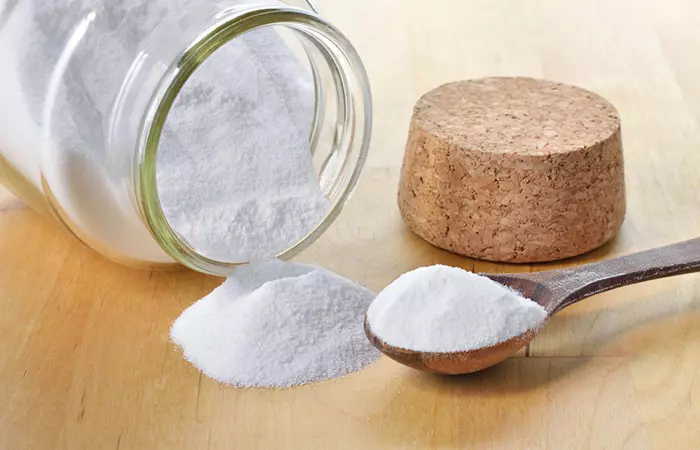
Baking soda is a popular home remedy and is mostly used for its exfoliating effects. It is believed to fade stretch marks by exfoliating the dead skin cells on the surface. However, there is no scientific evidence to support this claim. Additionally, some believe using baking soda on the skin can damage the skin as it is abrasive. Consult your dermatologist for more clarity in this regard.
You Will Need
- ½ teaspoon of baking soda
- Juice of half a lemon
- Cling wrap
What You Have To Do
- Mix the baking soda and lemon juice.
- Apply the mixture to the stretch marks.
- Wrap the area with the cling wrap and wait for 20-30 minutes.
- Remove the wrap and wash it off.
How Often You Need To Do This
2 times a week.
Note: If you develop skin irritation, stop using this remedy, and consult a dermatologist.
15. Baby Oil
Baby oil is nothing but mineral oil. A study states that mineral oil helps improve skin softness by reducing water loss (6).
You Will Need
Any baby oil
What You Have To Do
- Massage the baby oil on the stretch marks.
- Leave it on overnight.
How Often You Need To Do This
Every day before going to bed.
16. Breast Milk
Anecdotal evidence suggests that women who tried applying breast milk on their stretch marks during the postnatal period found it to be effective in fading them.
You Will Need
2-3 tablespoons of breast milk
What You Have To Do
- Massage/rub the breast milk on your stretch marks.
- Let it dry. Leave it on.
How Often You Need To Do This
1-2 times daily.
17. Almond Oil
Almond oil contains vitamins D and E. It helps to maintain the elasticity of the skin by keeping it moisturized (2).
You Will Need
1-2 tablespoons of almond oil
What You Have To Do
- Massage the almond oil onto the affected area.
- Allow it to get absorbed.
- Leave it overnight and wash the area the next day.
How Often You Need To Do This
1-2 times every day.
18. Sugar Scrub
Exfoliation is not enough to fade stretch marks and there is no proof that scrubbing the stretch marks can help fade your scars. However, since scrubbing is a way of exfoliating and stimulating the skin to shed dead cells and promote the development of new ones, you may try it out.
You Will Need
- 1 tablespoon of granulated sugar
- 1-2 teaspoons of almond or coconut oil
What You Have To Do
- Mix the two ingredients.
- Massage the mixture on the area for 5-10 minutes.
- Leave it on for another 15 minutes and let your skin absorb the oil.
- Wash it off with water.
How Often You Need To Do This
Once daily.
19. Tea Tree Oil
Tea tree oil is beneficial for wound healing and improving skin infection (7). However, there is no research to determine whether it can reduce stretch marks or not.
You Will Need
- 2-3 drops of tea tree oil
- 1-2 tablespoon of any carrier oil (use almond, coconut or olive)
What You Have To Do
- Dilute the tea tree oil with the carrier oil
- Massage the mixture on your stretch marks.
- Leave it overnight
Note
: Use tea tree oil only if you are not allergic to it. Do a patch test to determine if it suits your skin.
How Often You Need To Do This
Once daily.
20. Argan Oil
Applying argan oil improves skin elasticity and hydration levels (8). This helps to keep your skin healthy and may fade stretch marks gradually.
You Will Need
1-2 tablespoons of cold-pressed argan oil
What You Have To Do
- Massage the oil onto the stretch marks.
- Leave it overnight
How Often You Need To Do This
Once every day.
21. Turmeric
Turmeric
has therapeutic effects, whether it is taken orally or applied topically (9). However, there is no scientific evidence that it helps fade stretch marks. You may use it with any emollient for added skin benefits.
You Will Need
- ½ teaspoon of turmeric powder
- 1-2 tablespoon of coconut oil
What You Have To Do
- Mix the turmeric powder in coconut oil.
- Massage it onto your stretch marks (be careful as it might stain your clothes).
- Let it stay for at least half an hour.
- Wash off with water.
How Often You Need To Do This
Once every day.
22. Jojoba Oil
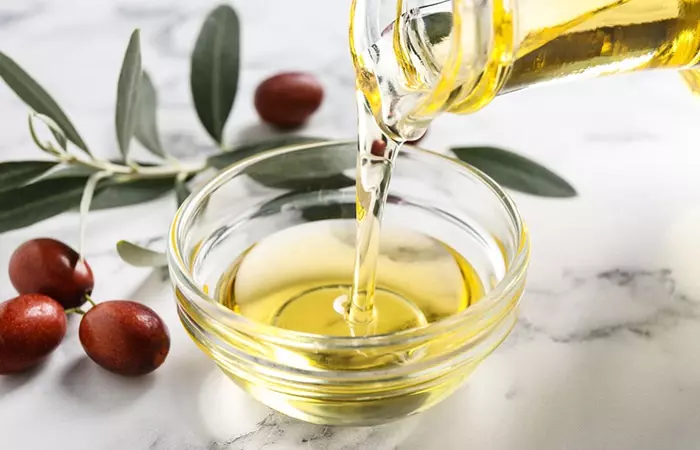
Jojoba oil is not an oil but a wax ester. It keeps the skin soft by moisturizing it (10). You may try using it to keep your scars moisturized and fade them naturally.
You Will Need
1 tablespoon of jojoba oil
What You Have To Do
- Massage the oil onto the affected area for 5-10 minutes.
- Leave it on overnight.
How Often You Need To Do This
Once every day.
23. Rosehip Seed Oil
Applying rosehip seed oil protects your skin from inflammation and reduces oxidative stress (11). These properties may help keep your skin healthy and fade stretch marks.
You Will Need
Rosehip seed oil
What You Have To Do
- Massage rosehip seed oil onto the affected area for 5 minutes.
- Leave it on overnight.
How Often You Need To Do This
Once daily.
24. Cucumber and Lemon Juice
Cucumber juice has a cooling effect when applied to the skin. Lemon is said to have a bleaching effect, which is why it is used in traditional remedies to brighten the skin.
You Will Need
- Juice of half a cucumber
- A tablespoon of diluted lemon juice
What You Have To Do
- Mix both the juices.
- Apply it on the affected area.
- Leave it to dry or for 10-15 minutes.
- Wash it off.
How Often You Need To Do This
Once every day.
25. Apricot Oil
Apricot oil is rich in vitamin E and fatty acids (12). It helps to keep the skin moisturized and soft. This may eventually help in reducing the appearance of stretch marks.
You Will Need
1-2 tablespoons of apricot oil
What You Have To Do
- Massage the oil onto the stretch marks for 5 minutes.
- Leave it on overnight.
How Often You Need To Do This
Once every day.
26. Emu Oil
Emu oil has moisturizing properties (13). It can also penetrate the stratum corneum (topmost layer of the skin) easily. Rat studies show that emu oil can reduce inflammation and promote collagen synthesis (14). Hence, it may help moisturize your skin and minimize the appearance of stretch marks. As it may cause skin irritation, do a patch test.
You Will Need
½ teaspoon of refined emu oil
What You Have To Do
- Massage the oil onto the stretch marks.
- Leave it on overnight or wash it off after keeping it on for at least half an hour.
How Often You Need To Do This
Once every day.
27. Aspirin
This is another popular remedy that has no scientific proof. Anecdotal evidence claims that aspirin can fade stubborn stretch marks.
You Will Need
- 2-3 aspirin tablets (no softgels)
- 1 tablespoon of warm water
What You Have To Do
- Crush the aspirin tablets.
- Make a paste of powdered aspirin and water.
- Apply it to the affected area.
- Leave it to dry and wash off.
- Follow up with a moisturizer.
How Often You Need To Do This
Once daily.
Note: Do a patch test to check for sensitivity.
28. Egg White
Egg white is another popular home remedy that lacks scientific backing. It is thought to make the stretch marks less noticeable with time.
You Will Need
The whites of two eggs
What You Have To Do
- Whip the egg white to give it a foam-like consistency.
- Massage it onto the affected area.
- Let it dry completely and then wash it off.
- Follow up with a moisturizer.
How Often You Need To Do This
2 times a day.
29. Potato Juice

Potato juice is widely used in home remedies and DIY masks to lighten the skin tone. Hence, it may help lighten the stretch marks and reduce their appearance.
You Will Need
1 potato
What You Have To Do
- Grate the potato and extract the juice.
- Apply the juice on the stretch marks. Let it dry.
- Wash it off and pat dry with a towel.
- Apply a moisturizer.
How Often You Need To Do This
1-2 times every day.
30. Hyaluronic Acid
Hyaluronic acid may help in treating stretch marks as it increases collagen and elastin production, which may help improve their appearance (15), (16).
You will Need
- 1 hyaluronic acid serum
What You Have To Do
- Cleanse your skin with a mild cleanser to remove any oil or dirt.
- Apply hyaluronic acid serum to the affected area.
- Gently massage it into the skin using circular motions.
- Follow up with a good moisturizer to lock in hydration.
How Often You Need To Do This
Once daily
Keep in mind that results from these remedies can differ from person to person. How quickly you notice visible results depends on your skin type and consistency. It is always best to consult a healthcare provider for personalized advice.
If you want to try other treatment options, you can consult a dermatologist. The dermatologist may suggest options, such as:
- Microdermabrasioni A painless noninvasive process that removes signs of aging by renewing the overall skin tone and texture. (17)
- Microneedling (18)
- Microneedling RFi A type of skin therapy that uses radiofrequency (a type of nontoxic radiation) to rejuvenate the skin by targeting scars from acne.
- Laser Therapy (19)
- Tretinoin and other topical creams (20)
- Chemical peels
- Platelet-rich plasma therapy
- Dermarolling
- Retinoids (21)
- Glycolic acid (21)
You get stretch marks when your skin is overstretched. Several risk factors may overstretch your skin.
Key Takeaways
- Regularly moisturizing your skin may improve skin elasticity, and may also help in stretch mark prevention.
- You can use easy home remedies like shea butter, aloe vera gel, coconut oil, castor oil, cocoa butter, Vick’s VapoRub, lemon juice, and potato juice to remove stretch marks.
- Exfoliating the skin regularly may make it smooth and help fade scars, thus reducing the appearance of stretch marks.
- Pregnancy, rapid weight gain or weight loss, and breast surgery to enlarge them are some of the factors that may lead to the development of stretch marks.
Who Is At Risk Of Developing Stretch Marks?
Certain people are more susceptible to stretch marks than others. You can better understand how to prevent stretch marks by being aware of the various factors that make you vulnerable to them. Learn more about them.
- Pregnancy: When you are pregnant, and as the fetus develops, the skin stretches to make space for the baby.
- Rapid weight loss or gain: When you lose or gain weight quickly by following a diet or due to other reasons, you may develop stretch marks.
- Genetics: Genetic factors may influence skin’s elasticity and how it stretches (1). If your parents had stretch marks, there is a higher risk that you might develop them.
- Hormonal changes: The hormonal changes experienced during puberty, pregnancy, and hormonal replacement therapy may make your skin more susceptible to stretch marks (1).
- Bodybuilding: When you are trying to build your muscles through exercise, they expand, which may stretch the skin and cause stretch marks.
- Corticosteroids: Using corticosteroids can affect the skin elastin and cause stretch marks.
- Breast Augmentation: This type of surgery expands your breasts and stretches the skin.
- Adrenal Gland Disorders: If you have adrenal gland disorders, such as Cushing’s Syndrome, Marfan’s syndrome, and Ehlers-Danlos Syndrome, you may develop stretch marks.
 Did You Know?
Did You Know?All of the above reasons can lead to stretch marks on your skin. Knowing these causes can help people take better care of their skin and prevent stretch marks from occurring in the first place. Learn some prevention tips in the next section.
Prevention Strategies
- Drink plenty of water to keep your skin moisturized.
- Maintain a healthy diet rich in vitamins and minerals.
- Moisturize your skin regularly with lotions or oils made for your skin type. This helps keep your skin soft and supple.
- Avoid trying to lose or gain a lot of weight at once. Follow a workout and diet regime that helps you reach your weight goals gradually to avoid skin stretching.
- Exercise to stay active as it will help improve your skin’s elasticity and overall health.
- Consult a doctor if you have a family history of stretch marks for personalized advice.
Infographic: Top 7 Home Remedies To Fade Stretch Marks
Stretch marks can occur due to rapid weight loss or gain and hormonal imbalance. To reduce the appearance of these lines from your skin, you can try home remedies like coconut oil, aloe vera, and turmeric, which improve your skin’s elasticity and overall appearance. Check out the infographic below to know the 7 best home remedies to fade stretch marks.
Some thing wrong with infographic shortcode. please verify shortcode syntaxStretch marks, also called striae, are long, thin lines that emerge when the skin stretches. These can be caused by a variety of factors, including weight gain or loss, hormone fluctuations, and pregnancy. Consistent self-care, paired with a healthy lifestyle and awareness of risk factors, can help reduce stretch marks and improve overall skin health. Moisturization with oils and emollients is essential to remove stretch marks as well as prevent them. Coconut oil, tea tree oil, breast milk, baking soda, sugar scrub, petroleum jelly, egg white, turmeric, and aspirin are popular ingredients used in home remedies for fading or preventing stretch marks. However, it is important to note that the efficacy of these remedies relies on anecdotal evidence rather than scientific data, so not every remedy will work for everyone.
Frequently Asked Questions
Is it possible to get rid of stretch marks completely?
No. While their appearance may improve with the right treatment, they will not go away completely.
How long do stretch marks take to fade?
Stretch marks may take between six to twelve months after pregnancy to fade. However, going through medical procedures like laser therapy or microdermabrasion may improve their appearance. You can consult your dermatologist for further information.
What skin type is more prone to stretch marks?
Dry skin may be prone to developing stretch marks due to a lack of moisturization and low elasticity. Drinking plenty of water and using moisturizing lotions will keep your skin hydrated and reduce the risk of developing stretch marks.
Illustration: Effective Home Remedies To Reduce Stretch Marks
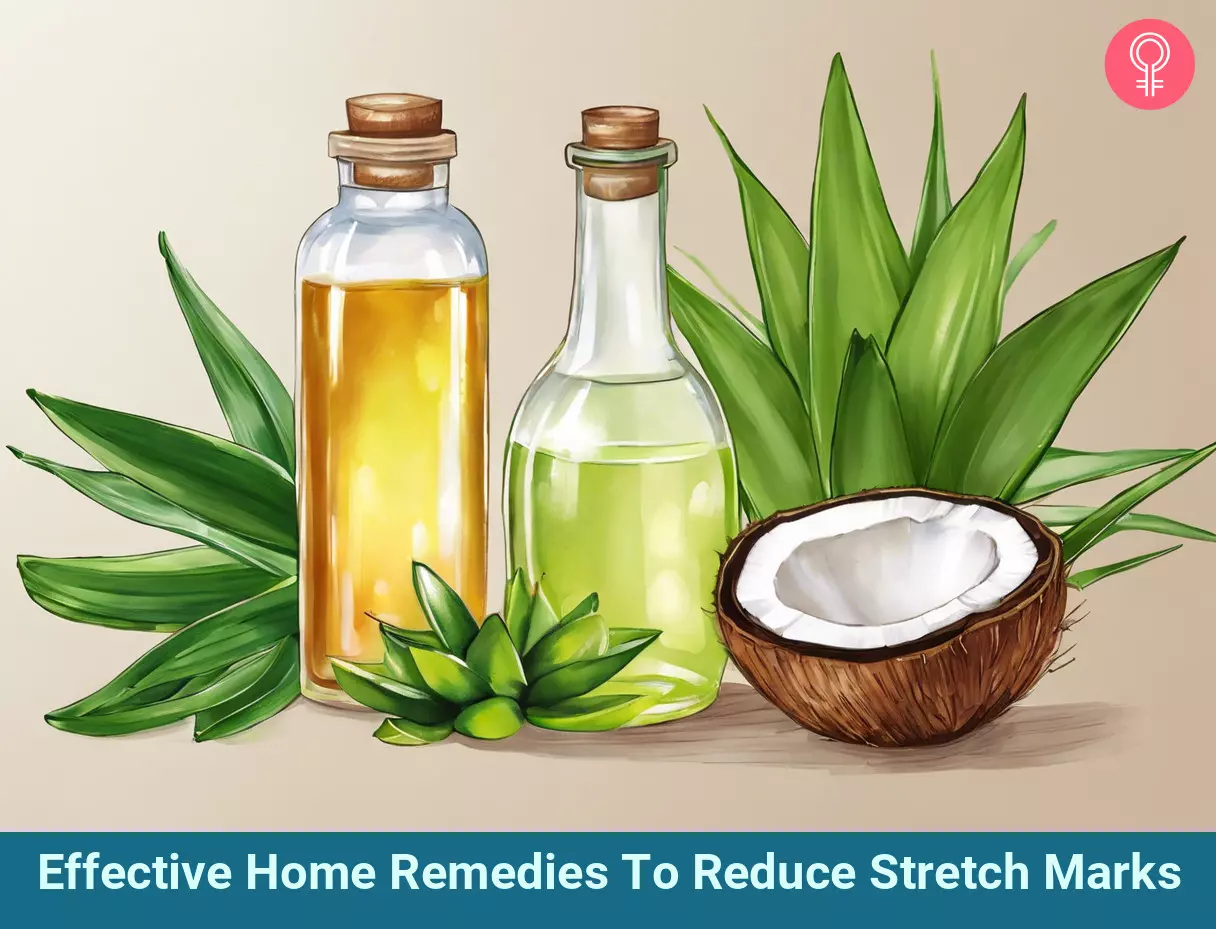
Image: Stable Diffusion/StyleCraze Design Team
Learn how to get rid of stretch marks on your body due to extreme weight changes! Watch the video below for tips and get ready to say goodbye to those pesky marks!
Personal Experience: Source
StyleCraze's articles are interwoven with authentic personal narratives that provide depth and resonance to our content. Below are the sources of the personal accounts referenced in this article.
i. HOW TO GET RID OF STRETCH MARKS & SCARS FAST!https://www.youtube.com/watch?v=S_6E0gjwMak
References
Articles on StyleCraze are backed by verified information from peer-reviewed and academic research papers, reputed organizations, research institutions, and medical associations to ensure accuracy and relevance. Read our editorial policy to learn more.
- Stretch Marks (Striae), StatPearls, US National Library of Medicine, National Institutes of Health.
https://www.ncbi.nlm.nih.gov/books/NBK436005/ - Topical management of striae distensae (stretch marks): prevention and therapy of striae rubrae and albae. Journal of the European Academy of Dermatology and Venereology, US National Library of Medicine, National Institutes of Health.
https://www.ncbi.nlm.nih.gov/pmc/articles/PMC5057295/ - Final report on the safety assessment of Ricinus Communis (Castor) Seed Oil, Hydrogenated Castor Oil, Glyceryl Ricinoleate, Glyceryl Ricinoleate SE, Ricinoleic Acid, Potassium Ricinoleate, Sodium Ricinoleate, Zinc Ricinoleate, Cetyl Ricinoleate, Ethyl Ricinoleate, Glycol Ricinoleate, Isopropyl Ricinoleate, Methyl Ricinoleate, and Octyldodecyl Ricinoleate. International Journal of Toxicology, US National Library of Medicine, National Institutes of Health.
https://www.ncbi.nlm.nih.gov/pmc/articles/PMC5057295/ - Aloe vera: a short review.” Indian Journal of Dermatology, US National Library of Medicine, National Institutes of Health.
https://www.ncbi.nlm.nih.gov/pmc/articles/PMC2763764/ - Effects of petrolatum on stratum corneum structure and function. Journal of the American Academy of Dermatology, US National Library of Medicine, National Institutes of Health.
https://pubmed.ncbi.nlm.nih.gov/1564142/ - A review on the extensive skin benefits of mineral oil. International Journal Cosmet Science, US National Library of Medicine, National Institutes of Health.
https://pubmed.ncbi.nlm.nih.gov/22994201// - A review of applications of tea tree oil in dermatology. International Journal of Dermatology, US National Library of Medicine, National Institutes of Health.
https://pubmed.ncbi.nlm.nih.gov/22998411// - Anti-Inflammatory and Skin Barrier Repair Effects of Topical Application of Some Plant Oils. International Journal of Molecular Sciences, US National Library of Medicine, National Institutes of Health.
https://www.ncbi.nlm.nih.gov/pmc/articles/PMC5796020/ - Effects of Turmeric (Curcuma longa) on Skin Health: A Systematic Review of the Clinical Evidence. Phytotherapy Research, US National Library of Medicine, National Institutes of Health.
https://pubmed.ncbi.nlm.nih.gov/27213821/ - Acute Effects of Transdermal Administration of Jojoba Oil on Lipid Metabolism in Mice
https://www.researchgate.net/publication/335853224_Acute_Effects_of_Transdermal_Administration_of_Jojoba_Oil_on_Lipid_Metabolism_in_Mice - A Systematic Review on the Rosa Canina Effect and Efficacy Profiles, Phytotherapy Research, Wiley Online Library.
https://pubmed.ncbi.nlm.nih.gov/18384191// - Formulation and evaluation of wild apricot kernel oil based massage cream, Journal of Pharmacognosy and Phytochemistry.
https://www.phytojournal.com/archives/2019/vol8issue1/PartQ/7-6-70-996.pdf - Moisturizing and cosmetic properties of emu oil: A pilot double blind study, Australasian Journal of Dermatology, Wiley Online Library.
https://onlinelibrary.wiley.com/doi/abs/10.1111/j.1440-0960.1996.tb01040.x - [Anti-inflammatory Activity and Healing-Promoting Effects of Topical Application of Emu Oil on Wound in Scalded Rats], Di Yi Jun Yi Da Xue Xue Bao, US National Library of Medicine, National Institutes of Health.
https://pubmed.ncbi.nlm.nih.gov/15837639// - Striae Distensae Treatment Review and Update US National Library of Medicine National Institutes of Health.
https://www.ncbi.nlm.nih.gov/pmc/articles/PMC6615396/ - A Narrative Review of Current Striae Treatments US National Library of Medicine National Institutes of Health.
https://www.ncbi.nlm.nih.gov/pmc/articles/PMC9777947/ - Management of stretch marks (with a focus on striae rubrae) US National Library of Medicine National Institutes of Health.
https://www.ncbi.nlm.nih.gov/pmc/articles/PMC5782435// - Treatment of striae distensae using needling therapy: a pilot study. Dermatologic Surgery US National Library of Medicine National Institutes of Health.
https://pubmed.ncbi.nlm.nih.gov/22913429// - Stretch Marks: Treatment Using the 1064-nm Nd:YAG Laser Dermatologic Surgery US National Library of Medicine National Institutes of Health.
https://pubmed.ncbi.nlm.nih.gov/18336578// - Topical Tretinoin 0.1% for Pregnancy-Related Abdominal Striae: An Open-Label Multicenter Prospective Study Advances in Therapy US National Library of Medicine National Institutes of Health.
https://pubmed.ncbi.nlm.nih.gov/11697021// - Interventions for established stretch marks Cochrane Library US National Library of Medicine National Institutes of Health.
https://www.ncbi.nlm.nih.gov/pmc/articles/PMC6483707/
Read full bio of Dr. CP Thajudheen
Read full bio of Ramona Sinha
Read full bio of Eshna Das
Read full bio of Shiboli Chakraborti







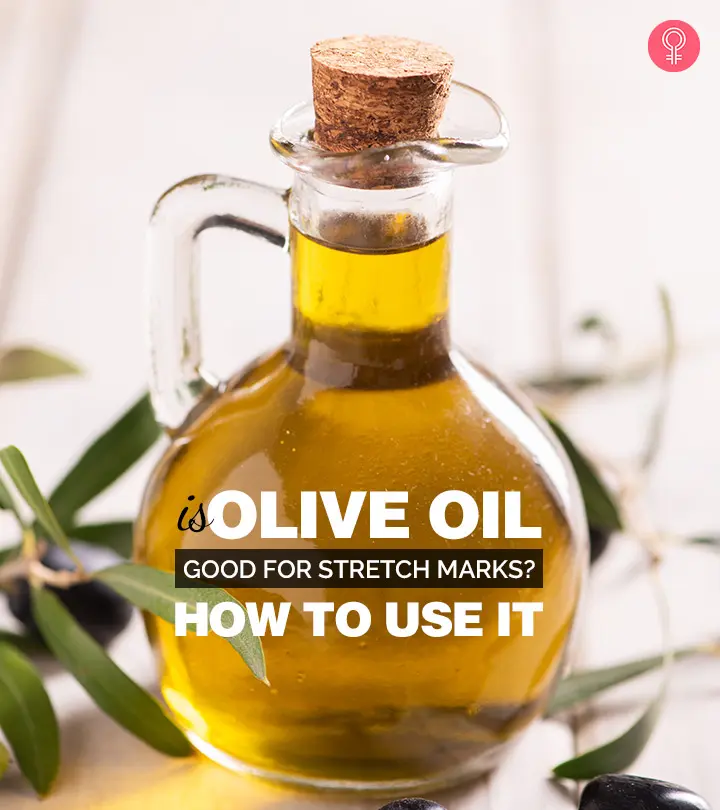


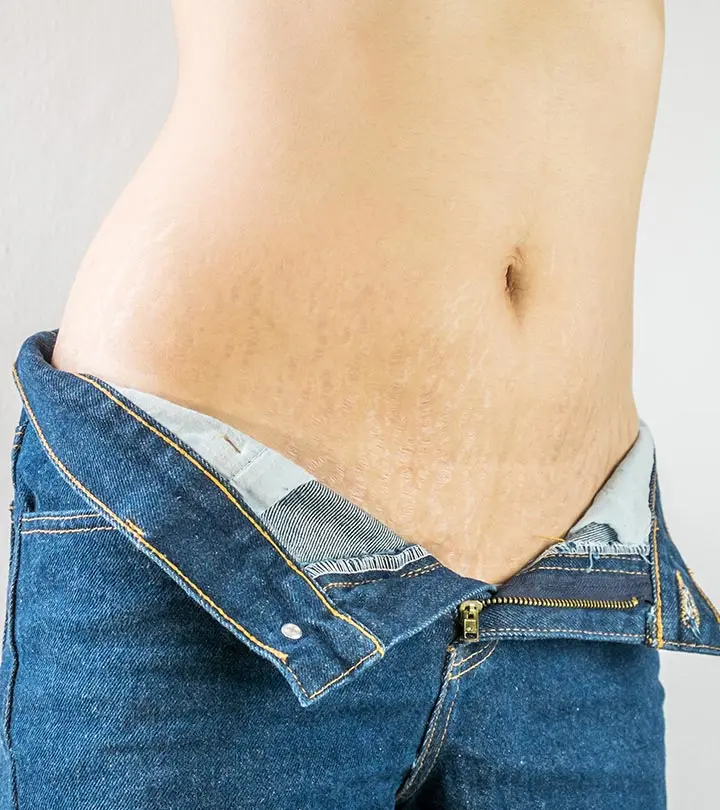

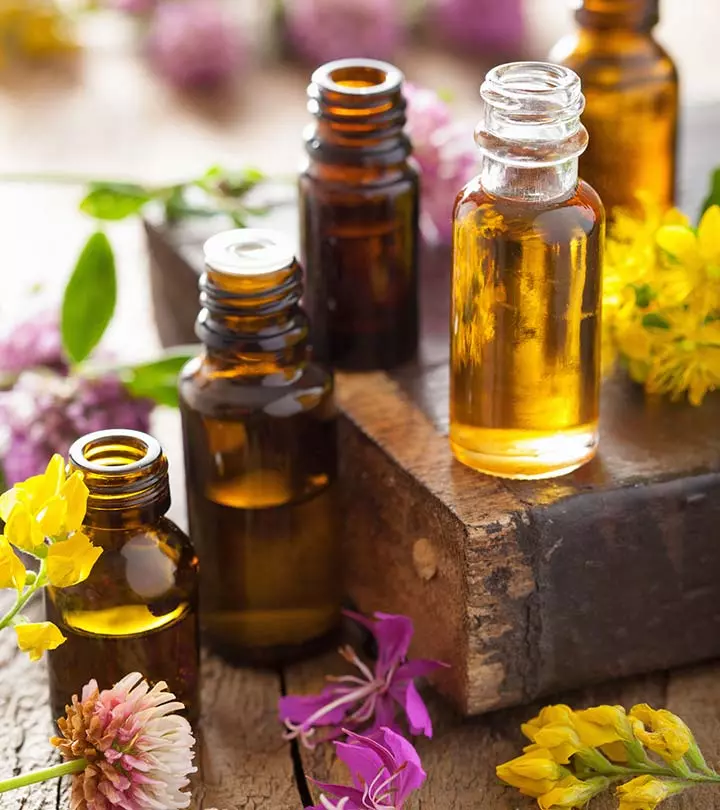



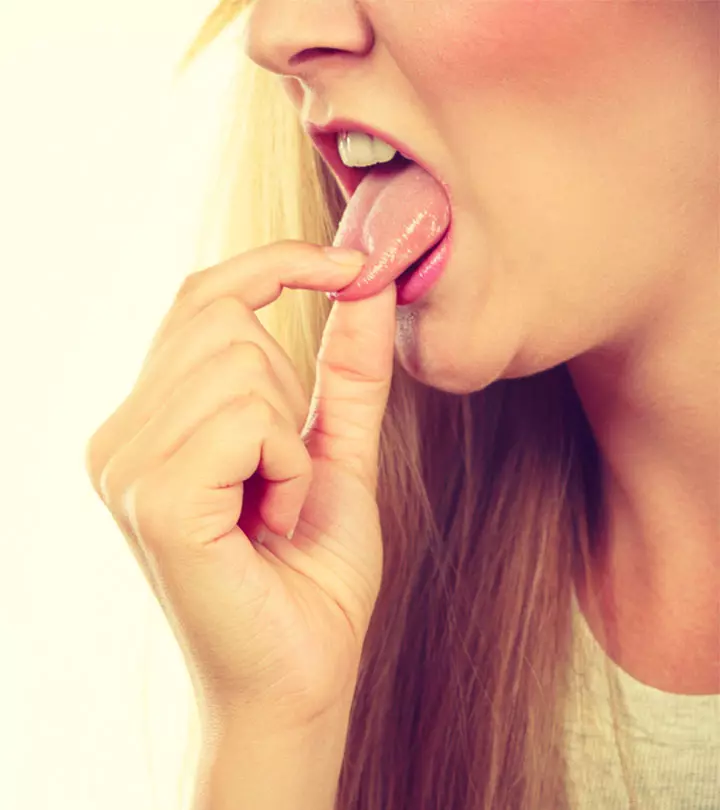



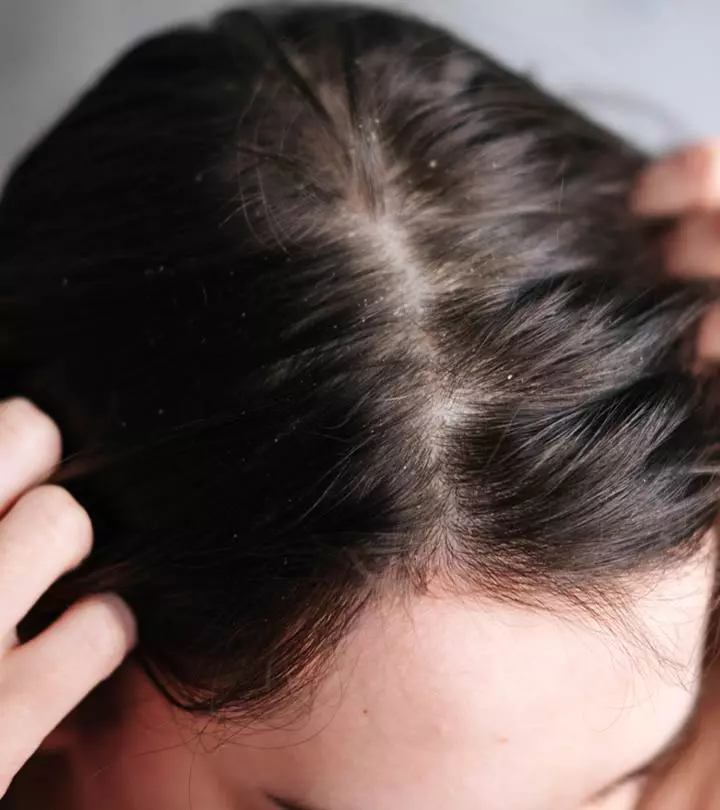






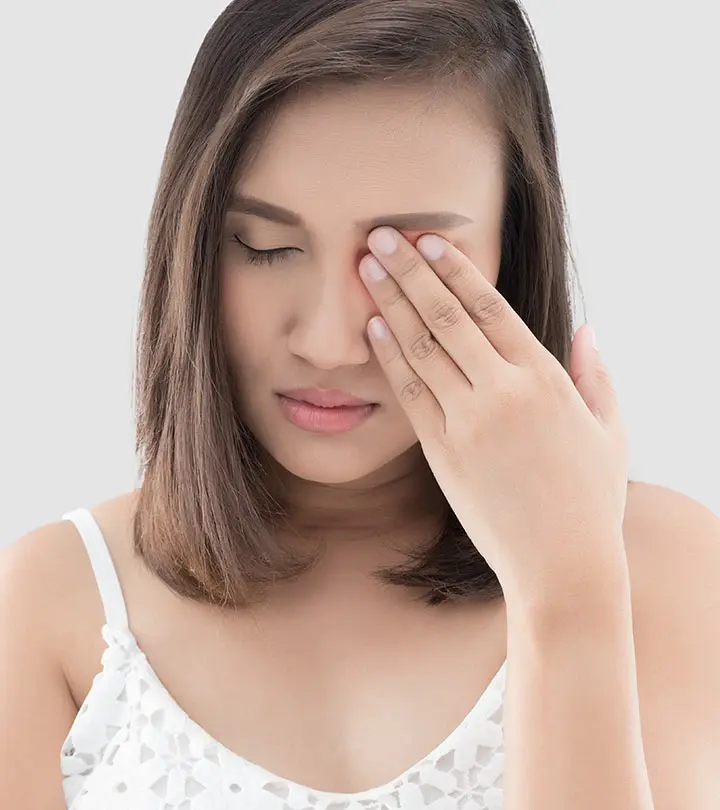
Community Experiences
Join the conversation and become a part of our empowering community! Share your stories, experiences, and insights to connect with other beauty, lifestyle, and health enthusiasts.